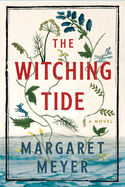
| Publisher: | Scribner | |
| Genre: | Women, General, Literary, Fiction, Historical | |
| ISBN: | 9781668011362 | |
| Pub Date: | September 2023 | |
| Price: | $28 |
| Starred | Fiction |
by Margaret Meyer
The Witching Tide, a 17th-century drama by Margaret Meyer infused with bewitching darkness, is set during a late summer heat wave in the fictional English seaside town of Cleftwater, a tight-knit community steeped in superstition that is forever changed by the arrival of a sinister London lawyer claiming to be a witch hunter. Mute since childhood, Martha Hallybread has lived in Cleftwater all her life, and is known for the healing tinctures she makes, her medicinal herb garden, and her midwifery skills. She is an enigmatic protagonist, the dark legacy of her past a painful memory even as she lives a peaceful life in the employ of a young couple, Master Kit and the heavily pregnant Mistress Agnes.
This is the first novel for England-based Meyer, who is a formidable storyteller; her sharp descriptive powers offer readers an immersive experience into Martha's silent world. As the pompous and self-important lawyer wreaks havoc on the women of Cleftwater with his witchcraft investigation, Martha turns to the strange little wax witching doll her mother left her, unsure of its powers but certain that she alone cannot save her friends and Mistress Agnes from the witch hunter's dangerous reach.
Perfect for fans of Margaret Atwood and Hilary Mantel, The Witching Tide is the remarkable story of the women who survived cruel, unjust imprisonment and went on to reclaim their rightful place in a community forever diminished by the hanging of so many innocent women. It is also a forceful interrogation of what happens when pious paranoia, stoked by ignorance, engulfs men already drunk on their own power. --Shahina Piyarali, reviewer

| Publisher: | Other Press | |
| Genre: | World Literature, Cultural Heritage, Political, Chile, Biographical, Fiction | |
| ISBN: | 9781635423891 | |
| Pub Date: | September 2023 | |
| Price: | $21.99 |
| Starred | Fiction |
by Ariel Dorfman
Ariel Dorfman's gripping and expansive mystery novel The Suicide Museum revolves around a central question: Did Chilean president Salvador Allende die by suicide or murder? The main character is a fictionalized version of Dorfman himself, hinting at the author's real-life connection to the book's historical events: Dorfman worked for Allende at the time of the military coup that resulted in his 1973 death.
The story begins when Dorfman gets an offer he can't refuse. Dutch billionaire Joseph Hortha wants to know the truth about Allende's fate and enlists the writer's help in solving the mystery. As Dorfman says, "I needed money and he had it, he had more than he knew what to spend it on." From the start, though, Hortha's true motives are murky. The pair travels from the United States to South America and ultimately to London in pursuit of someone who can attest to Allende's last moments, and each is forced to contend with guilt and trauma from the past.
As Dorfman learns more about Hortha's deeply personal connection to the mystery, and his unusual plan to save humankind from destruction, he must grapple with the task at hand, loyalty to those close to him (and in particular his steadfast wife, Angélica), and pivotal life events that still haunt him. Unlike most thrillers, this cerebral tale also serves as a history lesson and a philosophical contemplation on humanity's shared fate, making it a thought-provoking high point in Dorfman's prolific literary career. --Angela Lutz, freelance reviewer
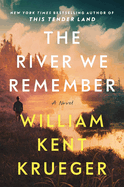
| Publisher: | Atria | |
| Genre: | Mystery & Detective, General, Literary, Fiction, Historical | |
| ISBN: | 9781982179212 | |
| Pub Date: | September 2023 | |
| Price: | $28.99 |
| Fiction |
by William Kent Krueger
William Kent Krueger's The River We Remember is the story of a close-knit farm town simmering with secrets. On Memorial Day in 1958, the people of Jewel, Minn., honor the town's veterans with a traditional parade through the three-block business district. But soon "hatred from wars long past and wars more recent" reveals it "still had hooks set in so many hearts." Krueger (Ordinary Grace) displays his deep affection for nature, describing Jewel's setting as having "wild oats and goldenrod and blazing star and a dozen other wildflowers"; these line the lane to the Alabaster River, which "shimmered gold in the late afternoon light." But on this spring day, the bucolic site is tainted: Black Earth County's wealthiest landowner is floating in the Alabaster, the victim of a shotgun blast. As sheriff Brody Dern investigates the apparent murder of the notoriously cruel and heartless Jimmy Quinn, public sentiment targets Noah Bluestone, a Sioux whose ancestors were driven from the county. Bluestone returned from World War II with a Japanese wife, doubling the disdain of vocal racists. Tension builds as Dern searches for motives.
Krueger's well-developed citizens of Jewel provide multiple subplots. Quinn's survivors don't mourn; a colorful woman public defender gains the Bluestones' trust; two adolescent boys flirt with danger; and Dern grapples with the investigation while finally facing the emotional war wounds and truths buried in his heart. Quinn's death isn't tragic, but the fallout threatens deeply sympathetic townspeople, keeping readers mesmerized through the unpredictable climax of this often tender, evocative novel. --Cheryl McKeon, Book House of Stuyvesant Plaza, Albany, N.Y.
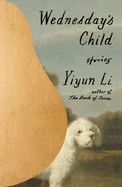
| Publisher: | Farrar, Straus and Giroux | |
| Genre: | Short Stories (single author), Literary, Asian American, Fiction | |
| ISBN: | 9780374606374 | |
| Pub Date: | September 2023 | |
| Price: | $27 |
| Fiction |
by Yiyun Li
The immigrant experience is exponentially complicated by a far more commonplace predicament: having to care for children. This is one unavoidable takeaway from Wednesday's Child, Yiyun Li's exquisite collection of stories of multipronged grief and dislocation.
The book's 11 stories largely revolve around Asian-born or Asian American women dealing with anxiety and loss in their or their parents' adoptive country, the United States. In "Hello, Goodbye," a Bay Area woman who is the daughter of Chinese immigrants fears that she's doing a terrible job raising her own daughters; "What blind courage," she wonders, "had led her into motherhood?" In "Let Mothers Doubt," a Mongolian American woman visits Paris following the fatal overdose of the younger brother she all but raised while their immigrant parents were running a Chinese restaurant in California's Central Valley. In "When We Were Happy We Had Other Names," a woman who grew up in Beijing and is living in the Midwest with her American husband copes with their teenage son's suicide by creating a spreadsheet to track everyone she has known who has died.
Li's protagonists can't easily articulate what weighs on them--because it's not articulable, because it's unspeakable, because it's too painful. Still, the women who helm these stories find ways to gain fresh purchase on their lives. Wednesday's Child highlights the vulnerability of children, but Li (Where Reasons End; Dear Friend, from My Life I Write to You in Your Life; Kinder than Solitude) allows for quiet acts of audacious resilience by women who have likely been fortified by their previous trials. --Nell Beram, author and freelance writer

| Publisher: | Tin House | |
| Genre: | Short Stories (single author), Literary, Fiction, Muslim | |
| ISBN: | 9781959030294 | |
| Pub Date: | September 2023 | |
| Price: | $17.95 |
| Fiction |
by Ghassan Zeineddine
A short story collection sparkling with humor and charming insight, Dearborn by Ghassan Zeineddine invites readers to experience contemporary life in the midwestern United States through the lens of Arab Americans who have settled in the titular Michigan city--men and women at various stages of reinvention, each striving toward their own version of the American dream.
For Yasser, a muscular Lebanese butcher with "furry hands," it means escaping his responsibilities on Friday mornings to dress up covertly as Yusra, his female alter ego, and to walk the streets as her, disguised conveniently in a niqab and abaya. To Hiyam, who fled civil war in Lebanon and is married to a wholesome American man, owning her own real estate business and driving a black Escalade with tinted windows represents the epitome of self-made success. Even while piously praying, she finds herself thinking, "I'm a CEO, bitches."
Zeineddine is an assistant professor of creative writing at Oberlin College, and a subtle comic undertone runs through his 10 stories, drawing on the naiveté of newcomers with Hollywood aspirations and Arab parents longing for that ultimate brag-worthy status symbol: to see their adult child's business advertised for all their friends to admire. "When will I see your gorgeous face on a billboard?" a mother beseeches her deadbeat son in "Zizou's Voice."
With an uncanny talent for peering deep into his characters' souls, and drawing on the basic humanity they share with their American neighbors, Zeineddine's stories illuminate the vast, comforting similarities culturally divergent communities share with one another. --Shahina Piyarali, reviewer
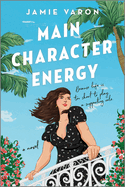
| Publisher: | Park Row | |
| Genre: | Women, Romantic Comedy, Family Life, General, Romance, Fiction | |
| ISBN: | 9780778334200 | |
| Pub Date: | September 2023 | |
| Price: | $18.99 |
| Fiction |
by Jamie Varon
The risks of making a fresh start permeate Main Character Energy, a smartly crafted and spunky romantic comedy, and the first novel by Jamie Varon. Single Californian Poppy Banks is stuck in a rut. The overweight 32-year-old suffers from a lack of confidence and self-worth. She's trapped in a "soul-sucking" writing job, the drama of familial expectations, and a mountain of debt from student loans and maxed-out credit cards. Added to this malaise are years of "disappointment, failure, rejection... and paralyzing writer's block" in her quest to become a published author. Her brother is already a bestselling author with a novel being adapted to film. Just as Poppy is about to ditch her dream, her Aunt Margot dies. Creative, free-spirited Margot, an expatriate who ran an elite writer's retreat in Cap Ferrat, France, had been estranged from her sister, Poppy's mother, yet secretly in contact with Poppy and supportive of her writing. Her death bequeaths an inheritance to Poppy with strings attached: if Poppy can run the writing center and finish her novel in six months, then the villa in Cap Ferrat will be hers.
Clever, astute Aunt Margot may have been long-lost to the family, but the orchestrations executed upon her death make it clear that she knew Poppy better than Poppy knows herself. Varon (Radically Content) delivers an immensely fun travel adventure. This well-plotted, lively rom-com is populated by a large cast of diverse, colorful characters, beguiling romance, and lots of pleasant surprises. --Kathleen Gerard, blogger at Reading Between the Lines

| Publisher: | Scribe US | |
| Genre: | Women, Asia (General), Friendship, World Literature, 20th Century - World War II, Fiction, Historical | |
| ISBN: | 9781957363622 | |
| Pub Date: | September 2023 | |
| Price: | $17 |
| Fiction |
by Dias Novita Wuri
Dias Novita Wuri makes her Stateside debut with Birth Canal, labeled a novella but more accurately a quartet of interlinked stories. Her haunting depictions of women surviving in different decades, countries, and situations--in a self-translated collection that adds up to a spare 160 pages--present a disturbing outlook on what happens in a world predominantly controlled by men. Wuri, a native Indonesian with a British education who is all too aware of colonial history, nimbly uses vivid storytelling to expose the vicious perils of domination and occupation.
Each story bears a woman's name. In "Nastiti," an unnamed male narrator in Jakarta reveals the complicated fate of his childhood friend; his unrequited love for her will ruin his relationship with his longtime fiancée. In "Rukmini," Nastiti's flight attendant mother, Arini, leaves Nastiti a note that she will be in Holland for a few days, where a Dutch researcher interviews Arini about her mother Rukmini's brutal sexual enslavement by the Japanese military. Fast forward to "Hana," in which two military men--one Japanese, one American--recall war and its aftermath. Dara, the discarded Jakartan fiancée from "Nastiti," now enduring a loveless, childless marriage in Osaka, becomes obsessed with a porn star, dead by suicide. Wuri deftly manipulates points of view, shrewdly deciding who gets to tell whose story--ones about the consequences of casual sex as disclosed by a wannabe lover, a Dutch interviewer recording an Indonesian's wartime tragedies, a rapist justifying his heinous crime. That Wuri's name, however, appears on the book's cover reads like a victorious reclamation of these tragic histories and contemporary consequences. In writing, Wuri commands authorial agency. --Terry Hong, BookDragon
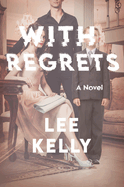
| Publisher: | Crooked Lane | |
| Genre: | Domestic, Apocalyptic & Post-Apocalyptic, Thrillers, Fiction, Technological, Science Fiction | |
| ISBN: | 9781639104673 | |
| Pub Date: | September 2023 | |
| Price: | $29.99 |
| Mystery & Thriller |
by Lee Kelly
A dinner party turns apocalyptic in Lee Kelly's With Regrets, a locked-room suburban drama that deftly balances the danger outside with the interpersonal disasters inside. The story is told in alternating chapters by four women at a party, allowing Kelly (A Criminal Magic) to keep information from readers as she develops intersecting plots. Recent New York City transplant and survival-fiction author Liz doesn't want to attend insufferable Britta's excessively planned "Sunday Soiree," but her husband insists they go so that they can mingle with their new neighbors. Britta's husband, Spencer, is tired of her obsession with living and documenting an Instagram-perfect life--and of hiding. New mother Padma is exhausted, overwhelmed, and depressed. And Mabel's attempts to keep her marriage together with church counseling and sheer determination are failing. The dinner party is already awkward and forced, but then "glimmering" murder clouds arrive. The deadly clouds floating around the planet are so odd they could almost be funny, except for the way they kill everyone exposed. As the clouds travel, they knock out wireless communications, dead animals fill the streets, and humans full of wriggling light fall dead.
With Regrets is as much about the secrets and resentments growing between spouses and neighbors as it is about the parents' fears for their children. Will Liz be able to get home to her children? Will the tension between Spencer and Britta boil over? Is that a gun? This sharply observed survival drama--imagine that Liane Moriarty wrote The Stand--is urgent, biting, and surprisingly optimistic. --Suzanne Krohn, librarian and freelance reviewer
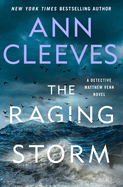
| Publisher: | Minotaur | |
| Genre: | Mystery & Detective, Traditional, Fiction | |
| ISBN: | 9781250836779 | |
| Pub Date: | September 2023 | |
| Price: | $29 |
| Mystery & Thriller |
by Ann Cleeves
Ann Cleeves--author of the Vera Stanhope (The Rising Tide) and Shetland Island mystery series, both of which are also television shows--explores the hidden facets of both the detectives and the suspects in her nuanced and analytical novels, perfect for fans of Louise Penny or Donna Leon.
The Raging Storm is her third novel (The Heron's Cry; The Long Call) to feature detective inspector Matthew Venn. Venn was raised among Devon's puritanical Barum Brethren and has returned to his childhood roots by moving back to the area with his husband, Jonathan. The body of Jem Rosco is found just outside the gloomy village of Greystone--a working-class town full of rigid Barum Brethren, unlike the rest of the popular Devon coast--during a massive storm. Rosco was an adventurer, TV personality, and sailor. Why did he choose a short-term rental here, of all places? Venn and his team delve into Rosco's past, discovering his youthful ties to Greystone, and learn that there are actually several residents who might have reason to resent his swashbuckling style. As violent autumnal storms continue to pound the coast, the detectives must struggle against both the weather and the reticent locals in order to find the truth.
Subtly atmospheric, The Raging Storm explores the adventurous life of Jem Rosco and the people he hurt, as well as Matthew Venn's complicated feelings about his conservative upbringing. Cleeves brings all of her characters to vivid life and will keep readers guessing until the very end. --Jessica Howard, freelance book reviewer
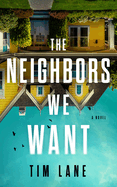
| Publisher: | Crooked Lane | |
| Genre: | Psychological, Small Town & Rural, Domestic, Suspense, Thrillers, Fiction | |
| ISBN: | 9781639104734 | |
| Pub Date: | September 2023 | |
| Price: | $29.99 |
| Mystery & Thriller |
by Tim Lane
Tim Lane (Rules for Becoming a Legend) delivers a fascinating story of solid domestic suspense in The Neighbors We Want. The novel, Lane's second, features characters who live on the same block in a Portland, Ore., neighborhood. They are people whom, in real life, anyone would want to steer clear of, and Lane visits them at their lowest. Adam and Sarah Cooper are at the worst time in their marriage. Adam has become a stay-at-home dad--or, as he likes to put it, a "SAHD with a silent H." It wasn't a family decision that he become full-time parent to their seven-month-old daughter, Maddie; he worked as an ad writer but was fired for viewing explicit videos at the office. Adam doesn't mind being a father but despises staying at home, with its endless feedings, diaper changings, and boredom, which he has tried to alleviate by spying on his neighbor Ali. Sarah, with her myriad secrets, equally resents bringing the sole paycheck, especially because Evie Kemp, the principal at the elementary school where she teaches, sends her inappropriate, sometimes sexual, texts. Evie's harassment includes wondering if her unhinged son, Crispin, prone to obsessing over women, is having an affair with Sarah while also stalking Ali. Adding to the creepiness, Evie spies on Sarah pumping her breast milk.
Lane's tangled web of deceit soars: violence escalates with arson, a possible murder, and ramped-up spying and stalking. The shifting points of view, realistic dialogue, and domestic scenes add to the believability of The Neighbors We Want. --Oline H. Cogdill, freelance reviewer
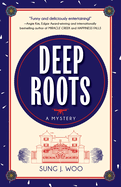
| Publisher: | Agora Books | |
| Genre: | Private Investigators, Mystery & Detective, Suspense, Thrillers, Asian American, Fiction, Women Sleuths | |
| ISBN: | 9781957957371 | |
| Pub Date: | September 2023 | |
| Price: | $17.99 |
| Mystery & Thriller |
by Sung J. Woo
Sung J. Woo (Love, Love) is one of those agile writers able seamlessly to insert detailed backstories mid-series: reading his second Siobhan O'Brien mystery, Deep Roots, without benefit of the inaugural Skin Deep is no less absorbing.
Siobhan runs the detective agency she inherited when her boss died suddenly. She's hired college student Beaker as her intern--and just in time, because she needs someone to check her e-mail while her new assignment takes her to a private island in the Pacific Northwest. Billionaire Philip Ahn has summoned her to Woodford, his expansive family mansion, to figure out if his youngest child, Duke, is truly his son. Octogenarian Ahn is a genius, specializing in artificial intelligence. But even his most advanced devices--personal drones, biometric apps--can't (or won't?) prove (or disprove) Duke is an imposter.
Siobhan arrives to find a surreal level of luxury. Employees ensure her every comfort, even dressing her for family meals, which entails exquisite, fit-to-the-skin clothing laid out on her most-comfortable-ever bed. She'll need to be suitably costumed to meet the entire Ahn clan: two ex-wives, the current wife, their assorted progeny. And then figure out how to escape their gilded prison.
Identity--and what makes a family--remains at the heart of Woo's series: Is Duke Duke?; the Ahns' overtly wannabe Eurocentric royal posturing (despite their ancestry traced to a 16th-century Korean admiral); Siobhan herself is Korean, adopted by a European couple; even Beaker, with his insights on "code switching." Clever, biting, and page-turning, Woo's PI series surely deserves future developments. --Terry Hong, BookDragon
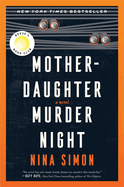
| Publisher: | Morrow | |
| Genre: | Women, Family Life, Mystery & Detective, Amateur Sleuth, General, Fiction, Women Sleuths | |
| ISBN: | 9780063315044 | |
| Pub Date: | September 2023 | |
| Price: | $30 |
| Mystery & Thriller |
by Nina Simon
In the appealing Mother-Daughter Murder Night, first-time novelist Nina Simon integrates spirited family dynamics with the intricacies of a complex whodunnit. Three generations of women come together under one roof in a little house in Elkhorn Slough, a coastal town in Monterey Bay, Calif. This all occurs when family matriarch Lana Rubicon--a 57-year-old, take-charge real estate mogul--faces an advanced cancer diagnosis. While undergoing treatment, her daughter, Beth, a geriatric nurse, insists that Lana, who is from Santa Monica, come and live with her and her 15-year-old daughter, Jack, Lana's granddaughter.
Lana and Beth's contentious relationship had been riddled with angst ever since Lana became a single mother when Beth was just a rebellious teenager. The strong and fiercely independent mother and daughter, navigating the emotional minefield of Lana's present illness and trigger points from the past, are forced to bury the hatchet when a young man who works for a local land trust is found murdered. The ensuing police investigation draws Jack, a kayak tour guide, into the list of suspects, and Beth and Lana, who once shared a passion for watching the crime drama Columbo, put their amateur detective skills to work. They become determined to exonerate Jack and root out the real killer--but not before another murder takes place that ups the ante.
This skillfully crafted multigenerational study of disparate characters will keep mystery readers guessing with its surprising, immensely well-plotted crimes and clues. --Kathleen Gerard, blogger at Reading Between the Lines
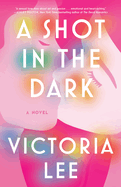
| Publisher: | Dell | |
| Genre: | Women, LGBTQ+ - Transgender, Romance, Contemporary, Fiction | |
| ISBN: | 9780593500514 | |
| Pub Date: | September 2023 | |
| Price: | $17 |
| Romance |
by Victoria Lee
A Shot in the Dark by Victoria Lee (A Lesson in Vengeance; The Fever King) is a queer romance with protagonists who will take up permanent residence in readers' hearts.
Ely Cohen is back in New York nearly a decade after her Orthodox Jewish family kicked her out at age 18; she's there for a summer art program where she hopes to learn from the famous but camera-shy artist Wyatt Cole. But what was supposed to be a one-night stand the night before her first class turns out to have major ramifications when the man who gave her the best sex of her life walks into the classroom the next day. In Grey's Anatomy style, it's Wyatt Cole. Wyatt tells Ely she can't be his student, because it would be unethical for him to have power over her after they'd slept together. Ely reluctantly enrolls in another teacher's class but makes Wyatt promise to help with her capstone project. What follows is a summer of almost-kisses as neither can resist the deep attraction between them.
Lee peels back layers of vulnerability for both artists as they heal from painful pasts, weaving a powerful and intimate story of intersecting conflicts. Ely is hot-headed and forceful, while Wyatt is hesitant and shy. Sparks fly when they're together. Ely's addiction and struggles with faith, Wyatt's addiction and trans identity, and the healing they offer each other all come together in achingly sweet moments. Honest and true to life, this is a story that will stay with readers long after turning the last page. --Dainy Bernstein, postdoc in children's literature, University of Illinois Urbana-Champaign
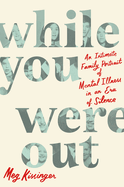
| Publisher: | Celadon | |
| Genre: | Biography & Autobiography, Editors, Journalists, Publishers, Family & Relationships, Death, Grief, Bereavement, Personal Memoirs, Health & Fitness, Mental Health | |
| ISBN: | 9781250793775 | |
| Pub Date: | September 2023 | |
| Price: | $30 |
| Starred | Biography & Memoir |
by Meg Kissinger
While You Were Out: An Intimate Family Portrait of Mental Illness in an Era of Silence by award-winning journalist and debut author Meg Kissinger confronts the devastating toll of mental illness on families in the United States. She tells the gripping story of eight siblings growing up with bipolar disorder and depression, and parents struggling with their own demons. Kissinger is brilliantly witty and heartbreakingly frank as she colors in the particular personalities of her sisters and brothers and describes the domestic chaos of their Wilmette, Ill., home, cherishing its coziness despite getting lost in the shuffle. Her recounting of their adventure-fueled antics is reminiscent of some of David Sedaris's best essays.
Kissinger, a journalism professor and investigative reporter who spent 20 years reporting on disgraceful conditions in mental health facilities across the country, had to confront the ethics of involuntary commitment, and what she refers to as the "third rail" of the mental health system: "when should a person's right to autonomy yield to their safety or the safety of others?" With a sister and brother lost to suicide, the haunting question of how they might have been saved lingers throughout the book. Learning about another person's in-depth experiences with emotional disorders in their family can offer cathartic support to readers dealing with similar struggles in their own lives. Kissinger is achingly honest about the fragile familial spaces left exposed by her siblings' suicides, while pointing to the redemptive power of sharing the pain openly, and rejecting the silence that previously paralyzed them. --Shahina Piyarali, reviewer
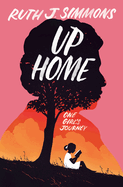
| Publisher: | Random House | |
| Genre: | Biography & Autobiography, Women, Personal Memoirs, Cultural, Ethnic & Regional, African American & Black, Educators | |
| ISBN: | 9780593446003 | |
| Pub Date: | September 2023 | |
| Price: | $27 |
| Biography & Memoir |
by Ruth J. Simmons
In her thoughtful, vivid debut memoir, Up Home, college president and scholar Ruth J. Simmons chronicles her childhood and her efforts to rise above her family's circumstances. She was the youngest of 12 children in a sprawling but fiercely loyal family and spent her early years in rural East Texas before moving to Houston. Simmons, born in 1945, grew up in a rapidly changing world, and her narrative charts her growing awareness of the world beyond the limits of Houston's impoverished Fifth Ward.
Simmons draws sharp portraits of the adults who shaped her: her quiet, hardworking mother; her volatile father who adored his baby girl; "Mamemma," her fiercely independent maternal grandmother; and her much older siblings. She credits her schoolteachers, beginning with her first teacher, Miss Ida Mae, with opening up her world. "Everything seemed possible with Miss Ida Mae," Simmons writes. She carried that sense of expansiveness through her elementary and secondary years, though her mother's death in 1961 was a terrible blow. Simmons, aided by caring teachers who helped her apply for scholarships, attended Dillard University in New Orleans, later spending time as an exchange student at Wellesley College and abroad. During her subsequent career in education, including her time as president of three different institutions--Smith College, Brown University, and Prairie View A&M University--Simmons has looked for ways to help students who may struggle in the college environment. Up Home is an insightful, straightforward portrait of the people and places that shaped the woman she has become. --Katie Noah Gibson, blogger at Cakes, Tea and Dreams

| Publisher: | Gallery Books | |
| Genre: | Biography & Autobiography, Self-Help, Celebrity & Popular Culture, Personal Memoirs, Topic, Motivational & Inspirational, Humor | |
| ISBN: | 9781982168568 | |
| Pub Date: | September 2023 | |
| Price: | $28.99 |
| Biography & Memoir |
by Maria Bamford
Comedian Maria Bamford never joined a cult cult. But her decades-long reliance on organizations with "Anonymous" at the ends of their names, and her attraction to "Unitarianism, Marie Kondo, and anything that will get me going in a fresh way," do suggest a susceptibility to the allure of new belief systems. Bamford explains all in her bracingly honest, brazenly funny first book, Sure, I'll Join Your Cult.
Bamford, who grew up comfortably middle class in Duluth, Minn., loves her family, but she's open to the possibility that her parents contributed to her shaky mental health. As a child, Bamford exhibited OCD behaviors, and her weight issues eventually led her to Overeaters Anonymous--"or, as I like to think of it, my first live-action role-playing game." It occurs to Bamford that her problems may have had something to do with not getting enough attention at home: "It was the '70s! Lord of the Flies parenting! The kids will work it out on their own!" Bamford may not have honed her comedy chops during the decade that she was tethered to her Suzuki violin, but thanks to her mom-mandated lessons, she recognized her first recital for what it was: "the gateway drug to a lifetime of performance-induced oxytocin."
Sure, I'll Join Your Cult's greatest utility may be Bamford's insider's report on how someone with "the mentals" can get by at work, especially in a field whose demands clash with a need to prioritize sleep and other means of sanity preservation. If she hadn't written this book, Bamford would have run out and bought it, and she would have loved it. --Nell Beram, author and freelance writer
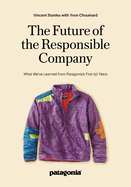
| Publisher: | Patagonia | |
| Genre: | Business Ethics, Business & Economics, Development, General, Commerce, Business Development, Management | |
| ISBN: | 9781952338113 | |
| Pub Date: | September 2023 | |
| Price: | $22 |
| Business & Economics |
by Vincent Stanley, Yvon Chouinard
The Future of the Responsible Company: What We've Learned from Patagonia's First 50 Years by Vincent Stanley with Yvon Chouinard is an instructive guide articulating the essential elements of business responsibility for these ecologically perilous times--and it is far more ambitious than a traditional business book. Defying "the god of consumer spending and its gospel of growth," the authors challenge organizations to prioritize not only shareholders and customers, but also workers, the community, and--most critically of all--the Earth. Stanley is Patagonia's director of philosophy and its longtime chief storyteller, and Chouinard is its adventure-loving founder. They didn't set out to make Patagonia into an environmentally and socially responsible company; they "stumbled into virtue after discovering we were causing harm," successfully transforming Patagonia into an activist company "in business to save our home planet," as enshrined in the apparel maker's mission statement.
The authors explore what it means to offer employees "meaningful work," so that they love their jobs while also having a positive impact on the world. Committed to not extracting Earth's precious, rapidly depleting resources for the goods they sell, Patagonia's business model focuses on reusing and recycling existing materials to make high-quality, well-designed gear that will last a long time. As the authors wisely point out, "the greenest product is often the one the customer doesn't have to replace." The Future of the Responsible Company, featuring gorgeous color photos capturing nature's glory, concludes with a detailed checklist for creating an environmentally responsible business model, the ultimate yardstick being: What practices will "restore the Earth and its oceans and strengthen human society?" --Shahina Piyarali, reviewer
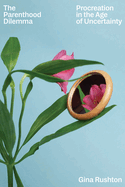
| Publisher: | Astra House | |
| Genre: | Family & Relationships, Parenting, Feminism & Feminist Theory, Marriage & Family, Sociology, Abortion & Birth Control, General, Social Science | |
| ISBN: | 9781662602382 | |
| Pub Date: | September 2023 | |
| Price: | $27 |
| Social Science |
by Gina Rushton
In The Parenthood Dilemma: Procreation in the Age of Uncertainty, Gina Rushton, a reproductive justice journalist, faces the very personal question of whether or not to become a mother in an age that feels incompatible with parenting. Rushton has long held that she did not want kids of her own, a "sweeping verdict that the world is no place for another child and that I am not supposed to be a parent." But after a diagnosis of endometriosis in her 30s, she became overwhelmed by and obsessed with the question, determined to make a decision before her body made it for her.
The Parenthood Dilemma starts with an emphasis on reproductive rights and justice in the 21st century, before considering the legacy and role of labor (inside of the home, outside of the home, and the mental and emotional variety); the very real threats of climate change; and the role of fertility (and infertility) and inheritance in one's decision to parent. Rushton is asking a question that is likely to resonate with anyone paying attention: "I want to know how people parent without living in permanent denial or perpetual dread." Even drawing on dozens of interviews from diverse voices, reams of research on parenthood and population growth, and countless hours of self-reflection, Rushton doesn't arrive at a clear answer to this existential question. But The Parenthood Dilemma, in its inability (or perhaps refusal) to offer a black-and-white response to a complex, messy inquiry, may actually be an answer in and of itself, inviting insight, reflection, and comfort. --Kerry McHugh
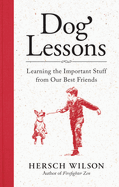
| Publisher: | New World Library | |
| Genre: | Self-Help, Pets, Dogs, General, Essays & Narratives | |
| ISBN: | 9781608688876 | |
| Pub Date: | September 2023 | |
| Price: | $24.95 |
| Pets |
by Hersch Wilson
Hersch Wilson's Dog Lessons: Learning the Important Stuff from Our Best Friends is part homespun meditation on what dogs teach humans and part memoir. Wilson writes movingly about 60 years of living with a total of 18 canines and the enlightenment inspired by these beloved companions. Wilson (Firefighter Zen), a Minnesota native, opens with an apology: "The second-largest religion in Minnesota, south of Lutheranism, is self-deprecation," he claims. Thus, quotes from esteemed writers precede each chapter and support his philosophies. "To sit with a dog on a hillside on a glorious afternoon is to be back in Eden, where doing nothing was not boring--it was peace," wrote Milan Kundera.
Wilson includes family memories in this "unabashed love letter to dogs," beginning with the memory of his mother taking him to pick out a German shepherd puppy at age 10 and the recent introduction of the family dogs to his newborn grandchild. His anecdotes and philosophies can meander like a dog following a scent: "be amazed at the complexity of cognition," he advises, making a comparison to dogs enthusiastically burying their snouts on walks. He also recommends, because canines are polyphasic, napping multiple times a day: "when the moment offers itself, NAP! Take a lesson from your dog." People don't "own" dogs, he stresses, but are their "guardians"; he notes that Ukrainian war refugees have taken their pets when evacuating. Dog Lessons is a carefully annotated work that is often funny and always loving. It is both an homage to nature in all forms and a gentle cautionary tale: while navigating the bridge of life, Wilson writes, "[c]ross it with a dog." --Cheryl McKeon, Book House of Stuyvesant Plaza, Albany, N.Y.
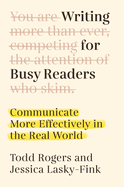
| Publisher: | Dutton | |
| Genre: | Style Manuals, Authorship, Business & Economics, Writing, Business Writing, Language Arts & Disciplines | |
| ISBN: | 9780593187487 | |
| Pub Date: | September 2023 | |
| Price: | $28 |
| Starred | Reference & Writing |
by Todd Rogers, Jessica Lasky-Fink
Time and attention are two of the most valuable resources people possess. The demands made upon both of these influence how people read--and if they even decide to engage with a particular piece of writing at all. Writing for Busy Readers by Todd Rogers and Jessica Lasky-Fink gives clear guidance on how to approach any written communication so that it serves both the aims of writers as well as those of the intended audience. Concision and precision are critical. The authors explain the principles of crafting "readable" writing, using common words and short, straightforward sentences that don't require extra effort on the part of readers. They also stress that the way information is designed is a critical component to crafting messaging that readers will process. Presenting the most important information first; separating distinct ideas while keeping related ideas close to each other; including heading elements that provide a clear road map for readers about what can be found where--the authors present all of these valuable recommendations alongside convincing examples and compelling data that make it clear that these tips are not their mere preferences. Additionally, they address when and how to include other visual elements and formatting that complement these solid writing principles.
The guidelines conclude with explicit suggestions for conveying why readers should care about a given message and how to make it easiest for them to take whatever action the writer is advocating, making this book an unequivocal must-have for writers of all kinds. --Elizabeth DeNoma, executive editor, DeNoma Literary Services, Seattle, Wash.
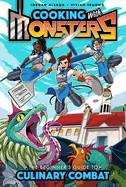
| Publisher: | IDW Publishing | |
| Genre: | Cooking & Food, Romance, Young Adult Fiction, Comics & Graphic Novels, Action & Adventure, LGBTQ+ | |
| ISBN: | 9781684059836 | |
| Pub Date: | September 2023 | |
| Price: | $16.99 |
| Starred | Children's & Young Adult |
by Jordan Alsaqa, illust. by Vivian Truong
This exuberant, action-packed YA fantasy graphic novel adds an inventive culinary twist to a magical boarding-school story.
The land of Gourmand "is full of monsters," most of whom "would just as soon eat you as look at you." Hana Ozawa is determined to become a warrior chef--one of Gourmand's "greatest protectors... and its most talented culinary expert." Hana and her best friend, Bobby Binh, follow their dreams to the Gourmand Academy of Culinary Combat, where students learn how to battle monsters and then turn them into five-star meals. Unfortunately, being a warrior chef isn't just about combat and cooking; Hana also must contend with an enigmatic mentor, a bully from her past, and a distractingly attractive rival student.
Author Jordan Alsaqa and illustrator Vivian Truong (The Awakening Storm) celebrate the culinary traditions of immigrant communities through Hana and Bobby, whose parents immigrated to Gourmand from the island countries of Hidaki and Trang, respectively. Gourmand Academy is inhabited by a diverse cast of characters with differing skin tones and body types who create fantastical meals inspired by real cuisine. Truong's dynamic manga-inspired art brings excitement to fight scenes as well as those featuring characters cooking up delectable dishes. Her striking portrayals of different monster species can be menacing, humorous, or adorable, and are as distinct as any Pokémon creature. Cooking with Monsters is a delightful concoction of imaginative, queer normative worldbuilding, thrilling action, and endearing characters. Fans of shōnen manga series like Naruto and My Hero Academia and magical school stories should enjoy this rollicking graphic novel. --Alanna Felton, freelance reviewer
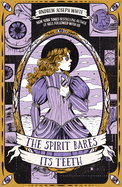
| Publisher: | Peachtree Teen | |
| Genre: | Paranormal, Occult & Supernatural, Fantasy, Young Adult Fiction, Historical, LGBTQ+ | |
| ISBN: | 9781682636114 | |
| Pub Date: | September 2023 | |
| Price: | $19.99 |
| Starred | Children's & Young Adult |
by Andrew Joseph White
Andrew Joseph White's sophomore novel, The Spirit Bares Its Teeth, is a riveting, spellbinding Victorian horror about a neurodivergent trans boy desperate to escape the life his family has planned for him.
Sixteen-year-old Silas has violet eyes that allow him to interact with spirits by lifting the Veil between the mortal world and the spirit world. Silas sees this ability as a curse and wishes he could live as his true self and become a surgeon. His parents, though, exploit his power and force him to suppress his trans identity. They believe that if Silas hides who he is, he will be ideal marriage material. After an unsuccessful attempt to avoid an arranged marriage, Silas is diagnosed with "Veil sickness" and placed against his will in an abusive sanitorium for violet-eyed medium girls. As he investigates why residents keep disappearing, Silas lives closeted: "I just need to find a way out.... And until then, I will keep myself safe."
White shows in this sharp, tense novel the same kind of visceral prose that garnered such acclaim for his debut, Hell Followed with Us. He paints an authentic and painfully tender portrayal of Silas's neurodivergent and trans identities and, in his author's note, explains that the book was inspired by "Victorian England's sordid history of labeling certain people 'ill' or 'other' to justify cruelty against them." The plot's candid, often gory accounts parallel the stunningly rendered characters whose physical and emotional wounds bleed out onto the pages. --Kieran Slattery, freelance reviewer, teacher, co-creator of Gender Inclusive Classrooms
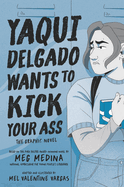
| Publisher: | Candlewick | |
| Genre: | Bullying, People & Places, General, Social Themes, Young Adult Fiction, United States - Hispanic & Latino, Comics & Graphic Novels | |
| ISBN: | 9781536234732 | |
| Pub Date: | September 2023 | |
| Price: | $12.99 |
| Children's & Young Adult |
by Meg Medina, illust. by Mel Valentine Vargas
In recognition of the 10-year anniversary of Meg Medina's Yaqui Delgado Wants to Kick Your Ass, Mel Valentine Vargas has adapted the Pura Belpré Award-winner into an inventive, compelling graphic novel. Vargas creates a new lens through which to view Piedad "Piddy" Sanchez's story by using sparse dialogue and highly emotive, limited-palette illustrations.
Vargas brings Piddy's emotional state immediately into focus by the choice to illustrate in grayscale and blue. The loneliness and sense of isolation are unmistakable as the young teen tries to navigate her new school and the befuddling animosity from a student she doesn't even know. ("Yaqui Delgado hates you.... she wants to know who the hell you think you are.") Vargas frequently makes use of close-ups on the eyes to communicate Piddy's inner conflict--her fear, confusion, embarrassment, desperation, rage. The artist elegantly employs a dichotomy, conveying the complexity of the young protagonist's experiences and emotions through spare text and minimalist drawings--with little to no background and extensive use of white space, the reader's eye is drawn to the strong emotion on the characters' faces.
Yaqui Delgado Wants to Kick Your Ass is a stirring account of school bullying that remains pertinent a decade after Medina's original release. By offering the story in the graphic novel format, Vargas makes Piddy a superhero as well as a protagonist who can teach bully victims that they can be the superheroes of their own stories. --Jen Forbus, freelancer
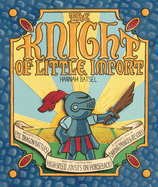
| Publisher: | Carolrhoda | |
| Genre: | Medieval, Animals, Dragons, Unicorns & Mythical, Social Themes, Self-Esteem & Self-Reliance, Juvenile Fiction, Historical | |
| ISBN: | 9781728450995 | |
| Pub Date: | September 2023 | |
| Price: | $19.99 |
| Children's & Young Adult |
by Hannah Batsel
Thinking globally may be a tall order for kids, but who's better suited to act locally? That's one takeaway from The Knight of Little Import, Hannah Batsel's galvanizing picture-book ode to community-mindedness. Another takeaway: small (towns) can be beautiful.
From her modest town of Little Import, young knight Charlie watches enviously as the knights of fancy-schmancy Biggerborough fight "mile-high dragons and ogres on the horizon." Apparently, "Little Import just wasn't worth a monster's time," thinks Charlie. Or is it? When Charlie hears that a late-night pastry thief has hit Mr. Galette's bakery, she becomes convinced that the villain is the notorious Triple-Tier Hungerbeak. (Readers will see that the "villain" is actually a mouse.) After Charlie catches the fiendish purloiner, word of her heroism gets around, and suddenly her services are needed all over Little Import: who else can capture, say, the gruesome garden-devouring Frenzied Mudbull? (It's actually a rabbit.) Okay, so these "monsters" aren't exactly fire-breathing giants. But after several weeks of problem-solving, Charlie looks around at her tidy town and happy neighbors and sees that "dealing with small monsters had made a big difference!"
For her collages, Batsel (A Is for Another Rabbit) works with a sweepingly wide range of unfussy materials, including thread, sawdust, and artificial turf--selections true to the spirit of this tale of resourcefulness, improvisation, and pluck. Although the author isn't so artless as to say so, The Knight of Little Import delivers the message that a good imagination is more rewarding than all the money in Biggerborough. --Nell Beram, freelance writer and YA author

| Publisher: | Atheneum Books for Young Readers | |
| Genre: | Emotions & Feelings, Superheroes, Humorous Stories, Social Themes, Juvenile Fiction | |
| ISBN: | 9781534418226 | |
| Pub Date: | August 2023 | |
| Price: | $14.99 |
| Children's & Young Adult |
by Jason Reynolds, illust. by Raúl the Third
Jason Reynolds (Track series) and Raúl the Third (Strollercoaster) join forces again in Stuntboy, In-Between Time, the hilarious and moving follow-up to Stuntboy, in the Meantime, about the new challenges faced by "the greatest superhero you've never ever heard of."
Portico Reeves (Stuntboy) is a tween Black superhero who suffers from terrible anxiety ("the frets"). Portico used to live in apartment 4D in Skylight Gardens with his mom, dad, Gran Gran, and their cat, A New Name Every Day. But now he lives on both the third and fifth floors--although Stuntboy's superpower is doing "all the hard stunts so the heroes don't have to do any," his powers weren't enough to save his parents' marriage. Now, all the "in-between time" that he spends not fully with either parent gives him the frets. When Portico and his friends find an empty and unlocked apartment on the eighth floor, Portico is ecstatic to have a place that's all theirs. But when they redecorate apartment 8H, they upset a few adults, and Stuntboy is worried none of his stunts will be enough to fix this catastrophe.
This humorous and exciting middle-grade illustrated novel is broken up into short episodes interrupted by helpful commercial breaks. Reynolds's text is accessible, providing a quick, entertaining read that directly covers topics of divorce, friendship, and anxiety. Raúl the Third's digital illustrations enhance the superhero tone with loose, sketchy lines that show movement; intentionally chosen pops of color in the grayscale art focus the eye on important details. Stuntboy, In-Between Time can be read as a stand-alone and is a perfect book for middle-grade readers who love superheroes. --Natasha Harris, freelance reviewer